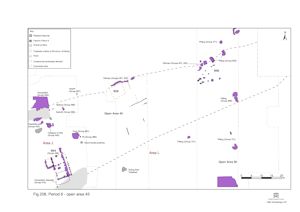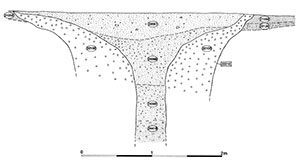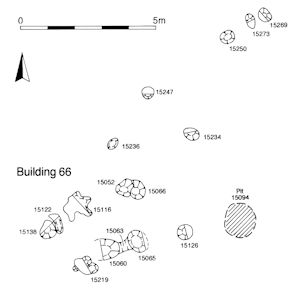
As already observed, the removal of the precinct wall must result in some blurring of the former separation of OAs 23 and 45 (Figure 208). Close to the (?former) temple and to Building 64 there are clear signs that some form of religious or ritual observance continues, with the deposition of coins and personal items in a range of features.
Period 5 ditch 25260/25262/25077/25078 persists in the landscape and continues to accumulate latest Roman material in its top. It is assumed that this boundary therefore continues to provide a tangible northern boundary to OA45 and that Building 59 survives alongside it.

Elsewhere in OA45, there is little to suggest concerted latest Roman activity. A cluster of post-holes might indicate further structures occupy its interior, but otherwise scattered pits represent the majority of the tangible Period 6 activity. There is nothing overtly Early Saxon within OA45, the only hints of continuing presence being in the form of single pottery sherds in a few pits and in seg. 15049 of ditch 25078.
While it is possible that votive deposition within defunct well 22210 begins earlier in the 4th century, the majority of such activity appears to take place in Period 6.

The redundant well either develops naturally or is deliberately converted into a water-filled pool (Group 987) (Figure 182) that is conveniently situated in front of the temple. The material deposited within the pool is clearly different from the assemblages found in contemporary pits elsewhere across the settlement and bulk materials such as building materials, pottery and bone are minimal. More significantly, the pool fills contain sixty-three coins,the majority of which derive from the upper fill 22051. There appears to be a general division of dates between the coins of the two fill deposits; the lower being late 3rd century and the upper 4th century, with anomalies between the two probably being due to cross-contamination during excavation. Accompanying the coins are small quantities of copper-alloy items such as a cosmetic probe (SF7954), possible bracelet fragment (SF7992), sheet, bar and tube fragments (SFs 7746, 7969, 7992) and an iron knife blade (SF7751). Perhaps even more distinctive is the deposition of fragments of shale bracelets (SFs 7953, 7968, 8049, 8076).
It is conjectured that the coins and personal items are deposited in the pool by visitors approaching or leaving the temple, perhaps making an offering as part of a rite of entry or departure. This votive practice continues until the late 4th century and seems not to be restricted to this one feature. Adjacent small pit 22062 (Group 986) also contains four jet bracelet fragments (SFs 7758-9, 7761-2) and a barbarous radiate (SF7760). This might suggest that other, undated, small cuts in the near vicinity of the former precinct wall and entrance may be the remains of further depositional activity that does not involve durable offerings (e.g. foodstuffs).
A cluster of miscellaneous post-holes (16302, 16386, 16390, 16392, 16480 Group 589) and a small pit (16450 Group 588) that contains twenty-four tesserae lie to the north of the votive pool. The principal significance of these features is that they extend across the line of Road 4 demonstrating that, at least beyond the temple precinct, it is not in use. As noted above, some or all of these may not in fact be structural, but rather small pits relating to further ritual deposition in this vicinity.

Located in that part of OA45 investigated within Excavation Area M, a cluster of small pits (15021, 15094) and post-holes (15269, 15273, 15250, 15247, 15234, 15236, 15052, 15126, 15066, 15116, 15138, 15122, 15063, 15060, 15219) demonstrate alignments that may indicate one or more phases of a building - Building 66 (Group 474). Although late 4th-century dating evidence is present in a few of these features, many others are undated. However, the cluster clearly impinges onto the line of the former Road 4 and might, therefore, genuinely represent a concentration of late activity, though the extent to which Building 66 represents a coherent structure is open to doubt.
Latest Roman pits seem to lie on either side of the ditch, in a band across the eastern parts of both Open Area 45 (Group 988) and Open Area 46 (Group 471), seemingly focusing upon the remains of this boundary. Those that technically fall within OA45 are pits 15005, 15245, 15354, 15356 Group 988). Like the Period 5 pits in this vicinity, they contain apparently domestic finds assemblages that are very similar to those of the Period 5 pits - large quantities of pottery, tile and metalwork, together with occasional stone fragments, which accumulate throughout the late 4th century and perhaps into the 5th. Some, such as pits 15005 and 15354 (Group 988) contain occasional sherds of Early Saxon pottery in addition to their latest Roman assemblages. This may indicate that the pits themselves continue to be filled this late, or that slump hollows that later developed in the tops of these Roman pits acquire scattered Saxon material. The rest of the finds assemblages from these 'Saxonising' features are otherwise indistinguishable from the latest Roman features.
Internet Archaeology is an open access journal based in the Department of Archaeology, University of York. Except where otherwise noted, content from this work may be used under the terms of the Creative Commons Attribution 3.0 (CC BY) Unported licence, which permits unrestricted use, distribution, and reproduction in any medium, provided that attribution to the author(s), the title of the work, the Internet Archaeology journal and the relevant URL/DOI are given.
Terms and Conditions | Legal Statements | Privacy Policy | Cookies Policy | Citing Internet Archaeology
Internet Archaeology content is preserved for the long term with the Archaeology Data Service. Help sustain and support open access publication by donating to our Open Access Archaeology Fund.